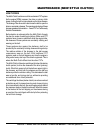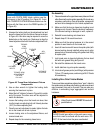
HHXD5 RIDE-ON TROWEL • OPERATION MANUAL — REV. #2 (05/04/12) — PAGE 43
MAINTENANCE
Refer to Figure 47 when installing pans onto finisher blades.
Figure 47. Z-Clip Finisher Pan Installation
1. Lift trowel just enough to slide pan under blades. Lower
finisher onto pan with blades assembly adjacent to
Z-Clips.
2. Rotate blades into position under Z-Clips. Ensure that
the blades are rotated in the direction of travel when
the machine is in operation or use the engine to rotate
the blades into position.
3. Attach the blade tie-downs to the far side of the Z-Clip
brackets with tie-down knobs as shown in figure 42.
4. Check to make certain that the blade edges are
secured under the Z-Clips and the tie-downs are
secured completely over the edges of the blade bar
before the machine is put back into operation.
Hydraulic Steering Pressure
Many hydraulic problems are a result of low fluid levels.
Before checking any other possibilities, make sure the
hydraulic fluid is at the proper level in the hydraulic fluid tank.
Blade Assembly
Tie-Down Knob
Tie-Down,
Blade
Z-Clip, Pan
WARNING
NEVER use your hand to find hydraulic leaks. Use a
piece of wood or cardboard. Hydraulic fluid injected into
the skin must be treated by a knowledgable physician
immediately or severe injury or death can occur.
Checking Steering Pressure
1. Remove the Left Side Access Cover and insert the test
pressure gauge (300 to 600 PSI) as shown in Figure
48 into the left steering valve's diagnostic quick coupler.
2. Verify the hydraulic fluid level is correct.
3. Start the engine and allow the unit to warm up.
4. Move the throttle lever to FULL engine RPM.
5. View the guage and record the reading.
Interpreting the Pressure Reading
CAUTION
This procedure will require two or more people.
The trowel will need to be "run up" while remaining
stationary or otherwise held in position. If a "hover" is
difficult to maintain the trowel can be butted up to 2 or
3 stakes or to some other none-moveable items.
WARNING
Charge/Steering Pressure must NEVER exceed 300
PSI nor go below 150 PSI. Pressure too high may result
in pressure leaks while pressure too low may result in
system damage.


















